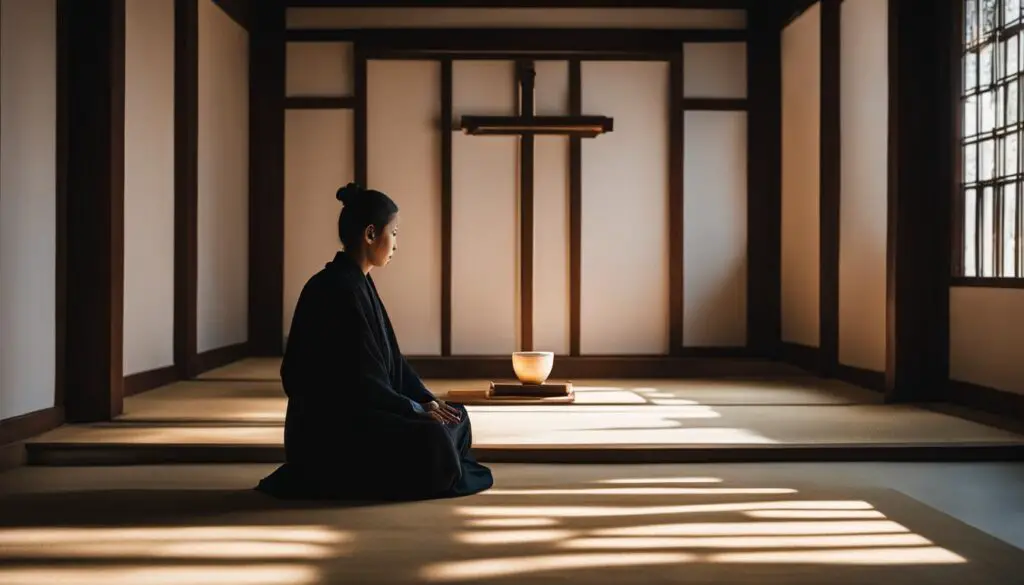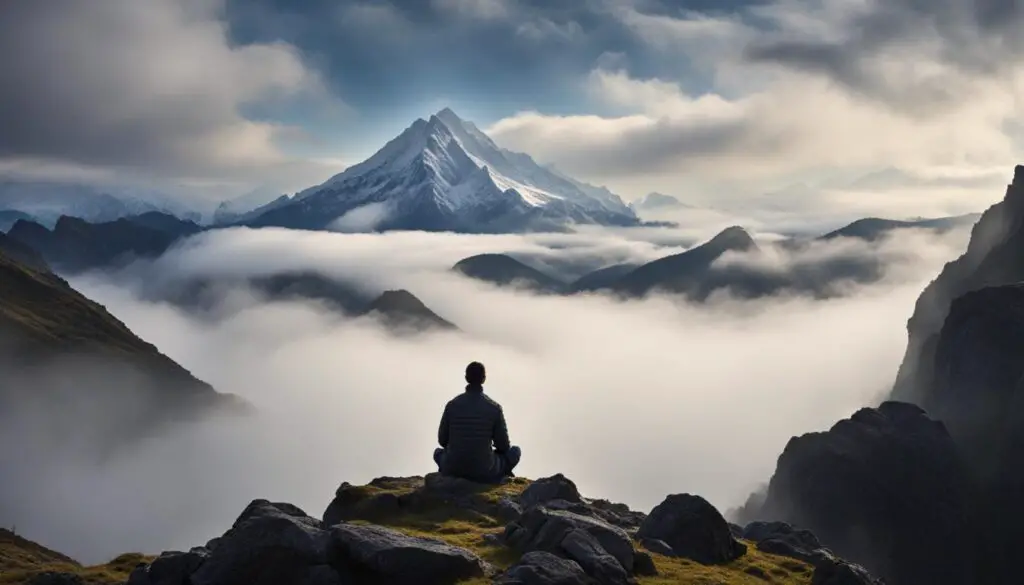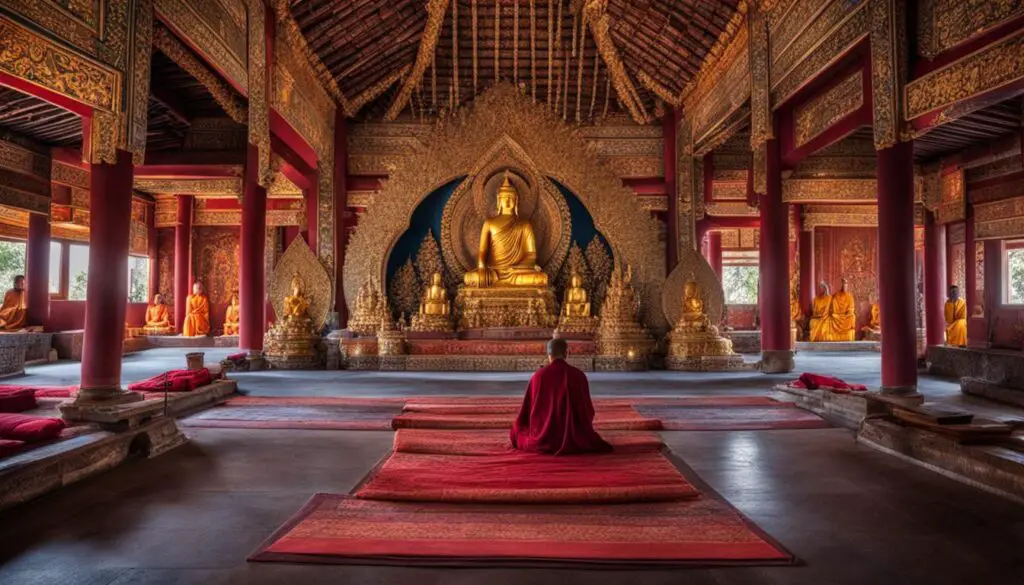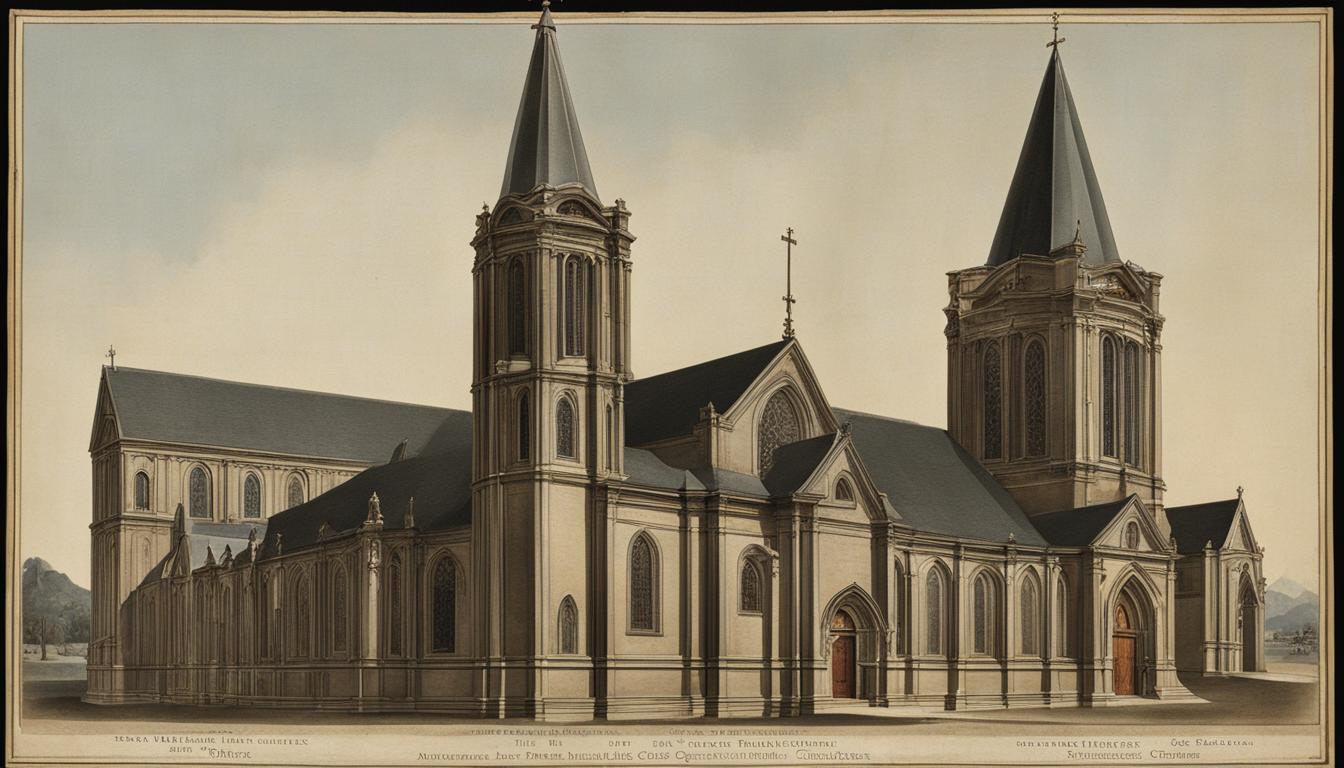Monastic movements have a rich history, deeply intertwined with religious communities dedicated to spiritual discipline and an ascetic lifestyle. While monastic traditions can be found in various religions, this article will focus on the monastic movements within Christianity, specifically the Buddhist Vajrayana tradition. By exploring these unique practices and beliefs, we can gain a deeper understanding of the profound impact these communities have had on individuals and society as a whole.
Key Takeaways:
- Monastic movements have a long history, shaped by religious communities devoted to spiritual discipline and an ascetic lifestyle.
- The practices and beliefs of monastic traditions vary between different religions and branches, with Christianity and Buddhism being prominent examples.
- Monks lead a life dedicated to spiritual growth, following a disciplined routine that includes rituals, prayer, and meditation.
- Monastic communities provide valuable guidance, mentoring seekers and offering a refuge for contemplation and retreat.
- The path of a monk requires dedication, self-discipline, and a renunciation of material possessions, leading to a frugal lifestyle focused on spiritual growth.
The Way of the Monk: Exploring Monastic Practices and Traditions
Monastic traditions have long captivated the hearts and minds of individuals seeking a deeper connection with the divine. Monks, through their dedicated practices and adherence to monastic traditions, offer a unique insight into a way of life centered around spiritual growth, inner peace, and contemplative living. In this section, we will delve into the various monastic practices and traditions that shape the lives of these devoted individuals.
Monastic Orders: A Tapestry of Devotion
Monasticism encompasses a rich tapestry of orders, each with its own distinct traditions and practices. From the Benedictines, known for their emphasis on community, work, and prayer, to the Franciscans, who embody a spirit of simplicity and service to others, monastic orders provide a framework for monks to live out their spiritual commitments.
The table below illustrates a comparison of selected monastic orders, highlighting their unique characteristics:
| Monastic Order | Traditions and Practices |
|---|---|
| Benedictines | Emphasis on community, work, and prayer. Following the Rule of St. Benedict. |
| Franciscans | Embrace simplicity and poverty. Committed to serving the marginalized and promoting social justice. |
| Trappists | Dedicated to a life of silence, solitude, and contemplation. Known for their strict observance of the Rule of St. Benedict. |
The Path of Spiritual Discipline
Monks follow a path of spiritual discipline that encompasses a myriad of practices. Central to their way of life are rituals, prayer, and meditation, which serve as vehicles for deepening their connection with the divine. These practices not only cultivate inner peace and clarity but also foster virtues such as humility, gratitude, and compassion.
As the renowned monk Thomas Merton once said:
“The life of the monk…is a life of contemplation, not only in the sense that it is dedicated to prayer and meditation, but also in the sense that it is deeply immersed in the silence and solitude that create the environment for contemplation to flourish.”
Through solitude and silence, monks create space for introspection, self-reflection, and communion with the divine. Their ascetic lifestyle, marked by simplicity and detachment from material possessions, allows them to focus on the pursuit of spiritual growth, unencumbered by worldly distractions.
Join us in the next section as we delve into the role of monastic communities in society, shedding light on their contributions to learning, mentorship, and spiritual guidance.
The Role of Monastic Communities in Society
Monastic communities play a vital role in society, offering individuals a refuge for contemplative living and religious retreats. These communities provide a space for individuals to disconnect from the chaos of everyday life and immerse themselves in introspection, meditation, and self-discovery. The practice of contemplative living allows people to find inner peace, gain a deeper understanding of themselves, and cultivate a sense of spiritual connection.
Religious retreats, organized by monastic communities, offer individuals the opportunity to temporarily step away from their busy lives and immerse themselves in a peaceful and reflective environment. These retreats often include periods of silence, meditation, and spiritual guidance from the resident monks or nuns. Participants can explore their own spirituality, seek answers to life’s questions, and gain a fresh perspective on their goals and priorities.
In addition to providing a refuge for contemplative living and religious retreats, monastic communities also serve as centers of learning and preservation of ancient knowledge. Monks and nuns dedicate their lives to the study and practice of religious texts, philosophy, and traditions. They become mentors and guides, sharing their wisdom and insights with those seeking spiritual growth and a deeper understanding of life’s mysteries.
Table: Benefits of Contemplative Living and Religious Retreats
| Contemplative Living | Religious Retreats | |
|---|---|---|
| Inner Peace | Enables individuals to find inner peace and tranquility in today’s hectic world. | Provides a peaceful and reflective environment away from daily distractions. |
| Self-Discovery | Allows individuals to explore their own spirituality and gain a deeper understanding of themselves. | Offers an opportunity for introspection and self-reflection, leading to personal growth and self-discovery. |
| Spiritual Guidance | Monks and nuns serve as mentors, offering spiritual guidance and wisdom. | Participants receive spiritual guidance and teachings from resident monks or nuns. |
| Knowledge and Wisdom | Monastic communities preserve ancient knowledge and share it with those seeking a deeper understanding of life’s mysteries. | Participants have the opportunity to learn from the extensive knowledge and wisdom of monks or nuns. |
Contemplative living and religious retreats provide individuals with the space and guidance needed to explore their spirituality, find inner peace, and gain a deeper understanding of themselves and the world around them. Monastic communities serve as valuable resources, offering a refuge from the demands of daily life and a sanctuary for personal growth and reflection.
The allure of contemplative living and the transformative power of religious retreats continue to draw individuals seeking a break from the noise and distractions of modern life. Whether it is a short retreat or an extended period of contemplative living, these experiences can bring about profound changes in one’s perspective, priorities, and overall sense of well-being. The role of monastic communities in society is invaluable, providing the space, guidance, and wisdom necessary for individuals to embark on transformative journeys of self-discovery and spiritual growth.
The Path of the Monk: Dedication and Renunciation
The path of a monk requires tremendous dedication, self-discipline, and a commitment to living simply. Many monks renounce material possessions and embrace a frugal lifestyle, focusing on the pursuit of spiritual growth rather than worldly pursuits. This renunciation allows them to experience a profound sense of freedom and detachment from the material world. Monks adhere to strict rules and spiritual disciplines, dedicating their lives to the pursuit of enlightenment and inner peace.
The ascetic lifestyle of monks is a testament to their unwavering commitment to spiritual discipline. By choosing to live with minimal material possessions, they free themselves from the distractions and attachments that can hinder their spiritual progress. This frugal lifestyle not only cultivates a sense of detachment but also fosters gratitude for the simple joys in life. Monks find fulfillment in the pursuit of inner peace and the exploration of the deeper dimensions of existence.
Through their dedication to simplicity and self-discipline, monks serve as powerful examples of the transformative power of renunciation. Their unwavering commitment to spiritual growth inspires others to reevaluate their own priorities and let go of the unnecessary burdens that life can bring. By stripping away the excess and embracing a minimalist lifestyle, monks create space for profound introspection and self-discovery.

The ascetic lifestyle of monks may seem challenging to many, but it is precisely this commitment to simplicity and renunciation that allows them to experience spiritual depth and inner peace. By embracing the path of the monk, individuals can learn valuable lessons about detachment, gratitude, and the pursuit of a meaningful life filled with spiritual growth and fulfillment.
The Allure of Monastic Movements: Inspiring Simplicity and Serenity
The simplicity and serenity of monastic movements have a profound allure in today’s chaotic world. The monks’ way of life, characterized by serene solitude, silence, and spiritual depth, offers a stark contrast to the fast-paced, consumer-driven society that many individuals find themselves in. In their pursuit of spiritual growth and inner peace, monks provide an inspiring example of the power of simplicity and a deep connection to the divine.
By embracing a lifestyle centered around serene solitude, monks create space for introspection, self-reflection, and communion with the divine. Removed from the distractions of modern life, they are able to delve deep into their own spiritual depths, exploring the mysteries of existence and finding solace in the silence. This practice of disconnecting from the external world and immersing oneself in the depths of one’s own being is a profound and transformative experience that holds great appeal.
“In the silence of solitude, we are able to hear the whispers of our souls and connect with the divine presence that resides within us.” – Monastic Teachings
Table: Contrasting the Allure of Monastic Movements
| Serene Solitude | Spiritual Depth | |
|---|---|---|
| Monastic Movements | Monks dedicate their lives to the pursuit of solitude, finding solace in their own company and the silence of their surroundings. | Through their rigorous spiritual practices, monks cultivate a deep connection with the divine, exploring the depths of their own being and the mysteries of existence. |
| Modern Society | Modern society is characterized by constant noise, distractions, and a lack of space for solitude and self-reflection. | In the hustle and bustle of modern life, the pursuit of depth and meaning is often overshadowed by materialism and surface-level pursuits. |
| Why it’s Alluring | The allure of serene solitude lies in the opportunity to disconnect from the noise of the world and reconnect with oneself on a deep and meaningful level. | The allure of spiritual depth lies in the quest for a greater understanding of oneself, the divine, and the interconnectedness of all things. |
Exploring the practices and teachings of monks can ignite a spark within us, urging us to reflect on our priorities, values, and the quest for a more meaningful existence. The allure of monastic movements lies in their ability to inspire us to seek simplicity, serenity, and a deeper connection with ourselves and the world around us. It is a call to embrace the transformative power of solitude, silence, and spiritual depth, leading us on a path towards greater clarity, peace, and fulfillment.
Discovering the Benefits of Monastic Practices
Incorporating some of the practices of monks into our own lives can lead to a greater sense of balance, clarity, and fulfillment. Meditation and mindfulness, central practices in the monastic lifestyle, have been scientifically proven to improve mental and emotional well-being. Embracing simplicity in our material possessions and lifestyle can also bring a sense of freedom and peace. By drawing inspiration from the monks’ unwavering commitment to spiritual growth and inner harmony, we can enhance our own spiritual journeys.

The Power of Meditation and Mindfulness
Meditation is a powerful practice that can help calm the mind, reduce stress, and enhance overall well-being. By focusing our attention and letting go of distracting thoughts, we can cultivate a sense of inner peace and clarity. Scientific studies have shown that regular meditation practice can lead to improved concentration, emotional resilience, and a greater sense of self-awareness.
Mindfulness, a key component of meditation, involves being fully present in the moment and non-judgmentally aware of our thoughts, emotions, and sensations. It allows us to observe our experiences with curiosity and acceptance, fostering a deep sense of connection to ourselves and the world around us. By practicing mindfulness in our daily lives, we can cultivate a greater sense of gratitude, compassion, and overall well-being.
The Power of Simplicity
In today’s fast-paced and consumer-driven society, embracing simplicity can be a powerful antidote to stress and overwhelm. Monastic practices teach us to detach ourselves from material possessions and the constant pursuit of external validation. By simplifying our lives, we can free up time and energy for what truly matters, such as cultivating meaningful relationships, pursuing our passions, and deepening our spiritual practice.
Simplicity also extends to our internal world, as we let go of unnecessary mental clutter and embrace a more focused and intentional way of living. By simplifying our thoughts and priorities, we can experience a greater sense of clarity, purpose, and contentment.
Embracing the Wisdom of Monastic Movements
As we explore the benefits of monastic practices such as meditation, mindfulness, and simplicity, we open ourselves up to profound transformation and personal growth. These practices offer us invaluable tools to navigate the complexities of modern life and cultivate a deeper connection to ourselves and others.
By incorporating elements of the monastic lifestyle into our own lives, we can experience greater peace, clarity, and fulfillment. Whether it’s dedicating a few minutes each day to meditation, practicing mindfulness in our interactions with others, or consciously simplifying our surroundings, every small step can contribute to a more meaningful and purposeful existence. Let the wisdom of monastic movements inspire us to embark on a journey of inner exploration and spiritual awakening.
Monastic Movements in Different Religious Traditions
Monastic movements can be found in various religious traditions, each with its unique practices and beliefs. Christian monasticism has a rich history, encompassing different orders and traditions within the Catholic, Orthodox, and Protestant branches of Christianity. These traditions have shaped the lives of countless individuals who have dedicated themselves to a life of prayer, solitude, and service to others.
Buddhist monasticism, particularly in the Vajrayana tradition, follows a similar path of renunciation and spiritual discipline. The monks, known as bhikkhus or sangha, devote themselves to meditation, mindfulness, and the pursuit of enlightenment. They adhere to a strict monastic code, known as the Vinaya, which governs their behavior and guides their spiritual practice.
While Christian monasticism emphasizes devotion to God and service to humanity, Buddhist monasticism places a strong emphasis on the cultivation of inner fire, harnessing energy to awaken spiritual potential, and the attainment of spiritual liberation. Despite the differences in beliefs and practices, both Christian and Buddhist monasticism share a common goal of seeking spiritual growth, inner transformation, and the realization of higher truths.
In Christian monasticism, the focus is on selfless love, humility, and the imitation of Christ, while Buddhist monasticism emphasizes the cultivation of wisdom, compassion, and the attainment of enlightenment.
The Similarities and Differences Between Christian and Buddhist Monasticism
To better understand the similarities and differences between Christian and Buddhist monasticism, let’s explore a table that highlights key aspects of each tradition:
| Christian Monasticism | Buddhist Monasticism | |
|---|---|---|
| Beliefs and Teachings | Emphasis on love, humility, and imitating Christ | Emphasis on wisdom, compassion, and enlightenment |
| Rituals and Practices | Prayer, liturgy, communal living | Meditation, mindfulness, monastic code (Vinaya) |
| Role in Society | Preservation of knowledge, education, spiritual guidance | Spiritual guidance, education, example of monastic life |
| Monastic Orders | Catholic, Orthodox, Protestant | Various schools within Buddhist tradition |
This table provides a glimpse into the similarities and differences between Christian and Buddhist monasticism. While each tradition has its distinct practices and beliefs, both offer individuals a path to spiritual growth, inner peace, and the realization of their highest potential.

Through their dedication to a life of simplicity, self-discipline, and devotion, monks from both Christian and Buddhist traditions inspire us to reflect on our own lives and the values we hold dear. Their teachings and practices serve as a beacon of light, guiding us on our own spiritual journeys, and reminding us of the importance of seeking a deeper understanding of ourselves and our place in the world.
The Influence of Monastic Movements on Culture and Society
Monastic movements have had a profound impact on culture and society throughout history. The influence of monks and monastic communities extends beyond the realm of religion, shaping various aspects of human civilization.
Preservation of Ancient Knowledge
Monks have played a crucial role in preserving ancient knowledge and traditions. In monastic libraries, countless manuscripts and texts have been painstakingly preserved, safeguarding valuable insights into history, philosophy, and various academic disciplines. This commitment to the preservation of knowledge has enabled future generations to access and learn from the wisdom of the past.
Development of Art and Architecture
Monks have also contributed significantly to the development of art and architecture. Monastic communities have produced breathtaking works of art, including intricate sculptures, magnificent paintings, and awe-inspiring architecture. Monasteries often serve as centers for artistic expression, where monks and skilled craftsmen create masterpieces that inspire and enrich society.
Promotion of Education and Learning
Education and learning have always been important aspects of monastic life. Monks have established schools, universities, and educational institutions, providing access to knowledge and fostering intellectual growth. Throughout history, monastic communities have been at the forefront of educational advancements, encouraging the pursuit of knowledge for the betterment of individuals and society as a whole.
| Impact of Monastic Movements | Examples |
|---|---|
| Cultural Preservation | Preservation of ancient texts and manuscripts |
| Architectural Influence | Creation of stunning monasteries and temples |
| Educational Advancements | Establishment of schools and universities |
Monastic movements have left an indelible mark on culture and society, with their contributions spanning centuries. Their influence can be seen in various fields, from literature and art to architecture and education. By understanding and appreciating the impact of monastic movements, we gain a deeper insight into the rich tapestry of human history and the profound role that spirituality and devotion have played in shaping our world.

Conclusion
Monastic movements offer a unique insight into a way of life centered around spiritual growth, inner peace, and contemplative living. Through the practices, traditions, and teachings of monks, we can find inspiration to reflect on our own priorities and values, and to seek a more meaningful existence.
Whether we choose to fully embrace the monastic lifestyle or simply incorporate some of their practices into our own lives, the lessons we learn from monastic movements can lead us on a path to greater clarity, peace, and fulfillment.
Let us embark on this journey of discovery, guided by the wisdom of those who have dedicated their lives to the pursuit of spiritual enlightenment. May we find solace in the monastic movements, and may they inspire us to cultivate spiritual growth and inner peace in our own lives.
FAQ
What is the history of monastic movements?
Monastic movements have a long and fascinating history, shaped by religious communities dedicated to spiritual discipline and an ascetic lifestyle.
What are the practices and traditions of monks?
Monks lead a life of solitude and contemplation, adhering to a disciplined routine that includes rituals, prayer, and meditation.
What role do monastic communities play in society?
Monastic communities act as centers of learning, preserving ancient knowledge and traditions, and provide spiritual guidance to seekers.
What is the path of a monk?
The path of a monk requires dedication, self-discipline, and a commitment to living simply, renouncing material possessions and embracing a frugal lifestyle.
How can monastic practices benefit individuals?
Incorporating practices such as meditation and mindfulness can improve mental and emotional well-being, while simplicity brings a sense of freedom and peace.
Are monastic movements found in different religious traditions?
Yes, monastic movements exist in various religions, including Christianity and Buddhism.
How have monastic movements influenced culture and society?
Monks and monastic communities have contributed to the preservation of ancient knowledge, development of art and architecture, and acted as moral compasses and sources of wisdom.
What can we learn from monastic movements?
Exploring monastic movements can inspire reflection on priorities, values, and the quest for a more meaningful existence, leading to greater clarity, peace, and fulfillment.
















